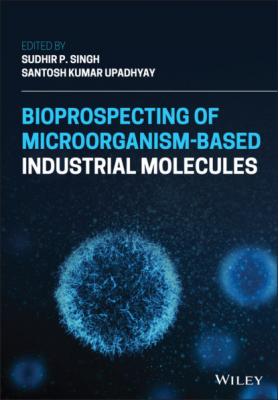Bioprospecting of Microorganism-Based Industrial Molecules. Группа авторов
Читать онлайн.| Название | Bioprospecting of Microorganism-Based Industrial Molecules |
|---|---|
| Автор произведения | Группа авторов |
| Жанр | Биология |
| Серия | |
| Издательство | Биология |
| Год выпуска | 0 |
| isbn | 9781119717263 |
2 Chapter 3Table 3.1 Microbial gums and their producer organisms.Table 3.2 Applications of microbial gums.
3 Chapter 4Table 4.1 Classification of aging theories.Table 4.2 Algal biomolecules, sources, origins, and applications in cosmeti...
4 Chapter 8Table 8.1 The databases and software tools used for in silico approaches for...Table 8.2 Bioactive compounds from the microbial origin and their applicatio...
5 Chapter 9Table 9.1 Electrocigens and functions.
6 Chapter 10Table 10.1 Production of UV protector compounds by microalgae.
7 Chapter 11Table 11.1 Summary of some critical studies on isolation, purification, and...Table 11.2 Different methods of antioxidant activity.
8 Chapter 12Table 12.1 Use of Biomethane in different European countries.Table 12.2 Different source and waste generators.
9 Chapter 14Table 14.1 Proximate composition of different microalgae species (%, based ...Table 14.2 Sulphated and exopolysaccharides found in marine microalgae.
10 Chapter 15Table 15.1 Major manufacturers of bioplastics worldwide.Table 15.2 Comparison of properties of PHB polymers with polypropylene.Table 15.3 Blends of PHB and their uses.
11 Chapter 16Table 16.1 List of persistent organopollutants degraded by white‐rot fungi ...Table 16.2 List of major fungal enzymes with their application details in b...
12 Chapter 17Table 17.1 Arabinoxylo‐oligosaccharides production and their microbial sour...Table 17.2 Isomaltooligosaccharides production and their microbial sources.Table 17.3 Lactosucrose oligosaccharides production and their microbial sou...Table 17.4 Xylooligosaccharides production and their microbial sources util...
13 Chapter 19Table 19.1 Entomopathogenic microbes with their target hosts.
14 Chapter 20Table 20.1 Factors affecting the development of single‐use technology.Table 20.2 Comparison of the bioreactors depending on the three different f...Table 20.3 Overview of the various applications of intensifying processes w...
List of Illustrations
1 Chapter 2Figure 2.1 3D chemical structure of lauryl sulfate as an example of a surfac...Figure 2.2 Chemical structures for two species of sophorolipids as a result ...Figure 2.3 General chemical structures for four types of rhamnolipids: monor...Figure 2.4 Number of publications on biosurfactants from 1963 to April 2020....Figure 2.5 Phyla of prokaryote producers of biosurfactants. Figure 2.6 CO2 formation rate (empty symbols) and O2 uptake rate (full symbo...Figure 2.7 Total CO2 formation (empty symbols) and O2 uptake (full symbols) ...Figure 2.8 Respiratory quotient observed during SL production by SSF.Figure 2.9 Evolution of pH during the production de sophorolipids.Figure 2.10 Kinetics for sophorolipid production (black) and substrates (○, ...Figure 2.11 Plot of the equation design of ideal bioreactors for the product...Figure 2.12 Simulation of sophorolipid production using the Gompertz model d...Figure 2.13 The plot of the equation design of ideal bioreactors for the pro...
2 Chapter 3Figure 3.1 Schematics of biosynthesis of microbial gums.Figure 3.2 Structures of different sphingans.
3 Chapter 4Figure 4.1 Summary of various characteristics of aging.Figure 4.2 Various intrinsic and extrinsic skin aging factors.Figure 4.3 Important carbohydrates from algae used in cosmetic applications....Figure 4.4 Important carotenoids pigments from algae used in cosmetic applic...Figure 4.5 Important secondary metabolites and mycosporine‐like amino acids ...
4 Chapter 5Figure 5.1 Metabolic pathways for bioremediation of organic pollutants and h...Figure 5.2 Workflow for the development of genetically engineered microorgan...
5 Chapter 6Figure 6.1 Representation of chemical structure of different organic acids....Figure 6.2 Illustration of different metabolic pathways involved in biosynth...Figure 6.3 Schematic diagram representing the proposed metabolic pathways us...
6 Chapter 8Figure 8.1 Culturable bioprospecting of novel bioactive compounds from micro...Figure 8.2 Steps involved in nonculturable bioprospecting using metagenomics...
7 Chapter 9Figure 9.1 Schematic diagrams of MFCs.Figure 9.2 Schematic diagrams of PMFCs.Figure 9.3 Schematic of typical dual‐chamber MFCs: (a) H‐type MFCs.(b) U...Figure 9.4 Schematics of type single‐chamber MFCs: (a) eight graphite anode ...Figure 9.5 Schematics of dual‐chamber of soil MFCs and PMFCs: (a) soil MFCs;...Figure 9.6 Schematics of single chamber of soil MFCs and PMFCs: (a) soil MFC...Figure 9.7 Schematics of air‐diffusion cathode systems.Figure 9.8 Other configuration of PMFCs: (a) flat‐plant design of PMFCs....
8 Chapter 11Figure 11.1 Chemical structure of amino acids associated with antioxidant ac...Figure 11.2 Chemical structure of pigments associated with antioxidant activ...Figure 11.3 Chemical structure of pedunculagin associated with antioxidant a...Figure 11.4 The chemical reaction for the development of different radical d...Figure 11.5 Conceptual presentation of the Fenton reaction.
9 Chapter 12Figure 12.1 Various sources of methane production.Figure 12.2 The sources of biological waste.
10 Chapter 13Figure 13.1 Cellulose synthesis pathway by Acetobacter xylinum. (NAD‐nicotin...
11 Chapter 14Figure 14.1 Schematic diagram of subcritical water extraction system.
12 Chapter 15Figure 15.1 Global production capacities of bioplastics.Figure 15.2 General structure and features of PHA.Figure 15.3 Life cycle of PHB.
13 Chapter 16Figure 16.1 Structure of laccase showing the positions of different Cu sites...Figure 16.2 Oxidation mechanism of lignin peroxidase.Figure 16.3 Enzymatic oxidation mechanism of MnP peroxidase.
14 Chapter 17Figure 17.1 Common examples of conventional and fortified FO.Figure 17.2 Some important conventional and upcoming functional oligosacchar...Figure 17.3 The production of AXOS.Figure 17.4 Production of IMO.Figure 17.5 Production of lactosucrose.Figure 17.6 Production of XOS.
15 Chapter 18Figure 18.1 Classification of algae.Figure 18.2 Various products of microalgal biomass.Figure 18.3 Transesterification reaction of triglycerides (overall reaction)...Figure 18.4 Microalgal biodiesel value chain stages.
16 Chapter
